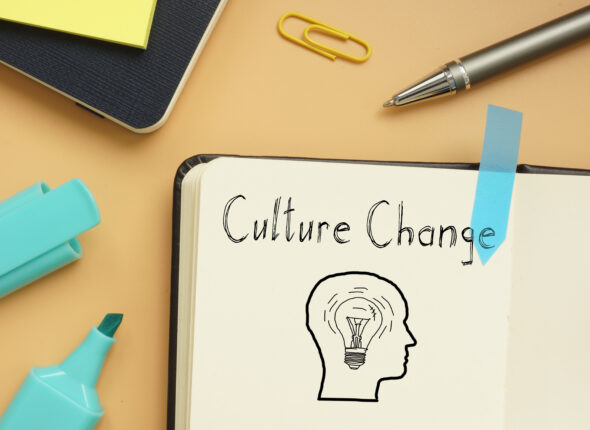In a rapidly evolving market, organizations constantly face the pressure to change. A cultural transformation can have profound impact on organizational success and competitiveness, even though it currently tends to be viewed as a passing trend by leaders. So why is it worth our attention and investment when seeking sustainable transformations?
Why Cultural Transformation Has Been Overlooked
Culture is often overlooked in organizational transformations. When working under constant pressure and at an increasing pace, leaders tend to focus on short-term objectives hoping for quick wins and improvements, such as reducing costs. Since cultural transformations are mostly considered a long-term investment, without immediate results, they are rarely a top priority for management teams and their positive impact is often neglected.
How a Winning Culture Shapes Successful Organizations
A closer look reveals that a focus on culture is worth the investment: organizations with a strong culture realize four times higher revenue growth than others. Culture is critical, it has a direct influence on the value of a company and can function as a differentiator in the marketplace. While organizational culture is perceived as a “soft factor” within an organization, in reality it is one of the hardest factors for success.
A cultural transformation involves a deliberate and systematic effort to shape an organization’s winning culture. A winning culture is built to carry change and innovation – it works towards collective progress and wins. To leverage the benefits of this and seize opportunities, we need to understand the five attributes characterizing a winning culture, which we see frequently with our customers.
- Awareness & flexibility: Successful organizations are constantly aware of internal and external changes, and they act on their observations. They are not bound by conservative approaches and can adapt their strategy to their environment’s demands.
- Collaborative attitude: Fundamentally, everyone is a team member and therefore part of a supportive unit. The workload is distributed via structures and roles, wins and failures are always within the responsibility of the entire team.
- Clarity of assets and methods: A winning culture understands its range of assets and knows how to apply them, fostering certainty in the team. The diverse strengths and skills of its members are acknowledged and embraced.
- Meaningfulness: The team shares a collective understanding of meaningfulness, which becomes the source of motivation. Continually pursuing the vision is a main leadership task and the winning culture drives the realization of the vision.
- Appreciation & growth: Winning cultures are shaped by the collaboration of committed members who contribute their individual competencies. Appreciating and supporting them is crucial.
A winning culture is what sets the most successful organizations apart from their competitors, allowing them to thrive. This is achieved by a set of beliefs and behaviors designed to enable the organization to consistently improve, innovate and take calculated risks to achieve greater success. This winning culture is aligned with the organization’s strategic objective and empowers employees to work together towards a shared goal.
Benefits from Establishing a Winning Culture
Investing in creating a winning culture pays off:
- Decreased costs: Engaged teams are highly committed to quality and improving customer relations and are more loyal towards their employer.
- Access to talent: A winning culture enhances the brand and helps attract more qualified and culturally fitting applicants.
- Improved knowledge management: Employees are invited to become more knowledgeable, acquire new skills, and focus on continuous learning which in turn helps the organization to retain or even increase their competitive edge.
- Increased productivity: A work environment built on trust improves employees’ motivation and satisfaction, resulting in increased sales, profit, and employee engagement.
- Greater flexibility: Organizations with a winning culture retain an agile mindset to respond to challenges quicker in more innovative ways, allowing for a competitive advantage.
How to Make Cultural Transformation Tangible to Effectively Shape a Winning Culture
It is one thing to recognize the benefits of a winning culture. Establishing it is clearly a different matter. By recognizing the four main challenges along the process of effectively shaping an organization’s winning culture, cultural transformation becomes more tangible:
- Culture has blind spots, is complex, and is additionally interwoven by nature. A systemic, holistic approach inherently recognizes that and builds the key to a successful transformation. The first step must be to define a comprehensive cultural transformation strategy. This includes the analysis of the existing culture and the system contexts to determine organizational interventions, identifying pain points and operational challenges.
- Often, organizations are unaware of their own culture, and often, it is not well understood. This calls for the creation of a common ground, allowing for a shared understanding of the prevailing culture of all stakeholders and social networks. Only with these elements included can culture be seen holistically, which in turn is crucial to identify the primary drivers of the existing and the desired culture.
- The core of any organization lies with its people, who tend to hold onto things intentionally or subconsciously. To dissolve this mechanism, the necessary transformation energy can develop by empowering and mobilizing the right people. A participatory approach ensures the involvement of employees to create the necessary sense of belonging and purpose throughout the transformation process.
- One of the most common pitfalls of transformations is the lack of reinforcement. To foster the understanding that cultural transformations are not a series of actions but rather a development process, change analytics can help to continuously monitor transformations. It needs the implementation of specific metrics, allowing insights on the effectiveness of interventions. Based on those results, decisions can be taken to efficiently steer efforts.
Towards a Winning Culture
To stay relevant in today’s world, organizations need to emphasize culture within their transformations. Cultural transformations aim at creating a winning culture to help unlock the true potential of an organization. To successfully transform a culture, the change effort needs to be made tangible by a systemic, holistic approach, which creates a common ground and aims to unlock the transformative energy within the organization.

